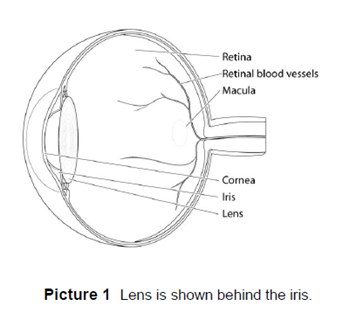Pediatric Cataracts

A cataract (KAT-a-rakt) is a clouding (whitening) of the lens of the eye, which is normally clear. The lens allows the eye to focus. It is located in the middle of the eye, behind the colored part (iris) (Picture 1). Cataracts can be present at birth (congenital) or the result of eye trauma (acquired). Cataracts can be inherited from parents. If your child’s cataract is inherited, you will get genetic counseling if it is needed.
When cataracts are small, not in the center of the lens and not dense, they often do not impact your child’s ability to see or their visual development. If the cataracts are large, in the center of the lens and more dense, they will cause a decrease in vision and poor visual development. A dense cataract makes the pupil, which is normally black, look white or grey. If surgery is needed to remove the cataract, it should be done as soon as possible. Without surgery, a child can develop amblyopia. This means vision stops developing in the affected eye.
Causes
Some causes of pediatric cataracts are:
- genetic diseases, such as Down syndrome
- metabolic disease
- long-term (chronic) use of steroids
- inherited from parents
- eye trauma
Signs and Symptoms
These symptoms may be signs that your child has cataracts:
- blurry vision
- eyes turned outward or crossed eye
- clouding (whitening) of the lens
- sensitivity to light
- weaker vision in affected eye
- white or dark pupil reflex in photos
Not all children with cataracts have symptoms. Young children can often function well by only using the unaffected eye to overcorrect for the eye with the cataract.
Diagnosis
Your child will be diagnosed after a complete dilated exam is performed. The dilation exam uses two sets of eye drops. These help the eye doctor (ophthalmologist) look at the inside and back of the eye.
Treatment
When a cataract is removed, your child will either get:
- A new lens inside their eye
- Glasses or contacts
These treatments replace the focusing power of the natural lens before it becomes a cataract.
Other Information
Adult cataracts are typically age-related (older than 60) and grow slowly. Adult cataracts are a normal aging process of the eye. Pediatric or congenital cataracts are more severe because they stop the normal development of vision in children under age 5.
Follow-Up Appointments
You can expect your child to have regular follow-up appointments with their ophthalmologist.
Call your child’s ophthalmologist if you need to make changes to the appointment.
HH-I-502 ©2021 Nationwide Children's Hospital
